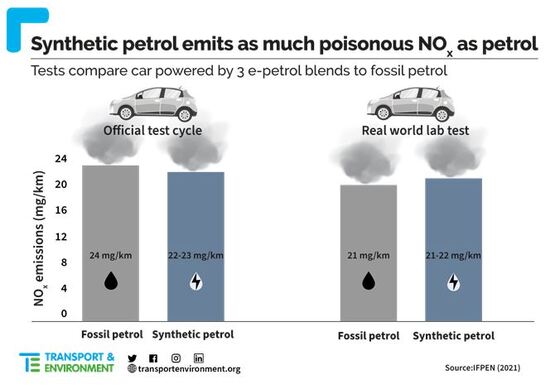E-fuels aren’t the answer
New study claims that tests show there are few benefits from using synthetic fuels
A new piece of research into the benefits of synthetic fuels say they fail in their purpose.
The pressure group Transport & Environment (T&E) claims that synthetic e-fuels are no cleaner. A series of laboratory tests compare the emissions from a car running on E10 petrol with three synthetic fuels. There was no perceptible difference in NOx emissions either in the lab or on road tests compared to today’s petrol fuel.
Poor performance
This means that the potential use of e-petrol in cars will have “little impact” on NOx emissions. These are “at the heart of toxic NO2 pollution” across Europe’s cities.

In fact, carbon monoxide emissions from e-fuels were found to be much higher in the tests. Emissions were up to three times higher in the lab test and 1.2-1.5 times higher on the real world test. The largest increase in emissions occurred when the engine was first switched on, according to the test.
“No amount of spin can overcome the science of burning hydrocarbons. As long as fuel is combusted in engines, toxic air will persist in our cities,” states Julia Poliscanova, senior director for vehicles and e-mobility at T&E. “Lawmakers who leave loopholes for e-fuels in emissions targets are condemning the public to decades more of avoidable air pollution.”
Silver lining
However, one positive result was the substantial decrease in particle emissions. These were observed on all e-fuel tests. The number of particle emissions (PN) larger than 10nm decreased by 97% in the lab test, and by 81-86% on the RDE test cycle. This is a significant improvement compared to the fossil fuel tested.
Hydrocarbon emissions from e-fuels decreased by 23-40% in the lab test too. There was no difference observed on the RDE test due to low emissions for all fuels.
Emissions of aldehydes – acetaldehyde and formaldehyde – also decreased with e-fuels when the engine was first switched on. However, there is no significant difference was seen on the test overall. These are potentially dangerous pollutants that are yet to be regulated.
Ammonia emissions of two e-petrol blends roughly doubled on the RDE test. Again, these increased particularly after the engine was first switched on. According to T&E, this is a precursor to PM2.5 pollution.
The engine
The independent testing was carried out by French research organisation IFP Energies Nouvelles. It used a Euro 6d-temp Mercedes A 180, on WLTC and RDE drive cycles performed on a chassis dyno.
Due to a lack of commercial production at present, IFP blended three e-fuel blends. This represents potential future fuels that are compatible with petrol cars. Two different 100% e-petrol blends and one blending 2nd generation ethanol (10%) and e-fuel were made.






